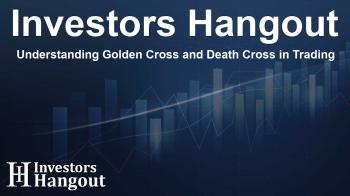Understanding Golden Cross and Death Cross in Trading

Understanding Chart Patterns: Golden Cross and Death Cross
Have you ever heard of the concept of a death cross in trading? The term can sound alarming, but it's not always an indication of impending disaster. On the contrary, the related golden cross may seem like an opportunity, but it can also be misleading. Let’s delve deeper into what these patterns really signify and why they are closely monitored by traders, especially when considering major indices like the S&P 500.
Decoding the Death Cross
A death cross occurs when a shorter-term moving average—usually the 50-day—falls below a longer-term moving average, like the 200-day one. This cross signifies that momentum is declining, and traders often interpret it as a bearish signal, suggesting that the market might slip into a downtrend.
Although a death cross shows that recent price activity has been weaker compared to long-term trends, it doesn't necessarily herald a market crash. Historical trends indicate that after the formation of a death cross, markets—including the S&P 500—often enjoy a brief rebound. An example worth noting is when the S&P 500 hit a temporary low shortly following such a cross.
Exploring the Golden Cross
Conversely, a golden cross occurs when the 50-day moving average surpasses the 200-day moving average. This favorably viewed situation is commonly interpreted as a bullish signal, indicating that momentum is gaining strength and traders might anticipate an upward rally.
The golden cross reflects increasing optimism and positive market sentiment. However, like its counterpart, this pattern is not infallible. Sometimes a golden cross appears when an ongoing rally begins to lose its momentum. Therefore, relying exclusively on these patterns can be misleading. A golden cross might look promising, but in some scenarios, it could imply a slowing trend rather than an acceleration.
Maximizing the Effectiveness of Crosses
Both golden and death crosses can serve as powerful indicators when combined with additional analytical tools. Savvy traders often employ them alongside other methods such as support and resistance levels, volume trends, trendlines, and even overarching economic factors to create a well-rounded trading strategy.
Utilizing Crosses in Trading the S&P
Among the most scrutinized chart signals for indices like the S&P 500 are the death cross and golden cross. These patterns can hold significant relevance for traders aiming to capitalize on movements in major market indices. Whether you're engaged in swing trading or focused on significant trend transitions, these chart patterns can provide critical timing signals—when interpreted accurately.
Remember, the next time you spot a cross on your chart, the focus is not on panic or elation, but rather understanding the market with clear insights.
Frequently Asked Questions
What is a death cross in trading?
A death cross is a chart pattern that occurs when a short-term moving average crosses below a long-term moving average, indicating potential bearish momentum.
What does a golden cross signify?
A golden cross is formed when a short-term moving average rises above a long-term moving average, often interpreted as a bullish signal suggesting upward market movement.
How reliable are these signal patterns?
While golden and death crosses can provide valuable insights, they are not foolproof and should be used in conjunction with other analysis tools for better accuracy.
Can markets rebound after a death cross?
Yes, historical data shows that markets, including the S&P 500, can experience brief recoveries following the formation of a death cross.
How can traders effectively use these cross patterns?
Traders should combine these signals with other techniques like analyzing support and resistance levels, volume trends, and broader economic data for enhanced decision-making.
About The Author
Contact Caleb Price privately here. Or send an email with ATTN: Caleb Price as the subject to contact@investorshangout.com.
About Investors Hangout
Investors Hangout is a leading online stock forum for financial discussion and learning, offering a wide range of free tools and resources. It draws in traders of all levels, who exchange market knowledge, investigate trading tactics, and keep an eye on industry developments in real time. Featuring financial articles, stock message boards, quotes, charts, company profiles, and live news updates. Through cooperative learning and a wealth of informational resources, it helps users from novices creating their first portfolios to experts honing their techniques. Join Investors Hangout today: https://investorshangout.com/
The content of this article is based on factual, publicly available information and does not represent legal, financial, or investment advice. Investors Hangout does not offer financial advice, and the author is not a licensed financial advisor. Consult a qualified advisor before making any financial or investment decisions based on this article. This article should not be considered advice to purchase, sell, or hold any securities or other investments. If any of the material provided here is inaccurate, please contact us for corrections.

